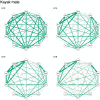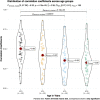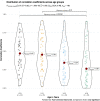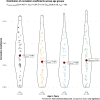Network analysis of associations between anthropometry, physical fitness, and sport-specific performance in young canoe sprint athletes: The role of age and sex
- PMID: 36506721
- PMCID: PMC9729946
- DOI: 10.3389/fspor.2022.1038350
Network analysis of associations between anthropometry, physical fitness, and sport-specific performance in young canoe sprint athletes: The role of age and sex
Abstract
Introduction: Anthropometric and physical fitness data can predict sport-specific performance (e.g., canoe sprint race time) in young athletes. Of note, inter-item correlations (i.e., multicollinearity) may exist between tests assessing similar physical qualities. However, multicollinearity among tests may change across age and/or sex due to age-/sex-specific non-linear development of test performances. Therefore, the present study aimed at analyzing inter-item correlations between anthropometric, physical fitness, and sport-specific performance data as a function of age and sex in young canoe sprint athletes.
Methods: Anthropometric, physical fitness, and sport-specific performance data of 618 male and 297 female young canoe sprint athletes (discipline: male/female kayak, male canoe) were recorded during a national talent identification program between 1992 and 2019. For each discipline, a correlation matrix (i.e., network analysis) was calculated for age category (U13, U14, U15, U16) and sex including anthropometrics (e.g., standing body height, body mass), physical fitness (e.g., cardiorespiratory endurance, muscle power), and sport-specific performance (i.e., 250 and 2,000-m on-water canoe sprint time). Network plots were used to explore the correlation patterns by visual inspection. Further, trimmed means (μtrimmed) of inter-item Pearson's correlations coefficients were calculated for each discipline, age category, and sex. Effects of age and sex were analyzed using one-way ANOVAs.
Results: Visual inspection revealed consistent associations among anthropometric measures across age categories, irrespective of sex. Further, associations between physical fitness and sport-specific performance were lower with increasing age, particularly in males. In this sense, statistically significant differences for μtrimmed were observed in male canoeists (p < 0.01, ξ = 0.36) and male kayakers (p < 0.01, ξ = 0.38) with lower μtrimmed in older compared with younger athletes (i.e., ≥U15). For female kayakers, no statistically significant effect of age on μtrimmed was observed (p = 0.34, ξ = 0.14).
Discussion: Our study revealed that inter-item correlation patterns (i.e., multicollinearity) of anthropometric, physical fitness, and sport-specific performance measures were lower in older (U15, U16) versus younger (U13, U14) male canoe sprint athletes but not in females. Thus, age and sex should be considered to identify predictors for sport-specific performance and design effective testing batteries for talent identification programs in canoe sprint athletes.
Keywords: athletic performance; multicollinearity; race time; relationship; talent identification; youth sports [MeSH].
Copyright © 2022 Saal, Chaabene, Helm, Warnke and Prieske.
Conflict of interest statement
The authors declare that the research was conducted in the absence of any commercial or financial relationships that could be construed as a potential conflict of interest.
Figures






Similar articles
-
Measures of Physical Fitness Improve Prediction of Kayak and Canoe Sprint Performance in Young Kayakers and Canoeists.J Strength Cond Res. 2023 Jun 1;37(6):1264-1270. doi: 10.1519/JSC.0000000000004055. Epub 2023 Apr 6. J Strength Cond Res. 2023. PMID: 34027911
-
The Effects of Trunk Muscle Training on Physical Fitness and Sport-Specific Performance in Young and Adult Athletes: A Systematic Review and Meta-Analysis.Sports Med. 2022 Jul;52(7):1599-1622. doi: 10.1007/s40279-021-01637-0. Epub 2022 Jan 21. Sports Med. 2022. PMID: 35061213 Free PMC article.
-
Gender- and Sport-specific Normative Anthropometric and Physical Values in Talent-Identified High School Athletes.J Strength Cond Res. 2023 Mar 1;37(3):606-615. doi: 10.1519/JSC.0000000000004312. Epub 2022 Jul 8. J Strength Cond Res. 2023. PMID: 35836319
-
Paralympic Versus Olympic Canoe Sprint: Comprehension of the Development Trajectory of the Kayak 200 Meters.Percept Mot Skills. 2024 Aug;131(4):1291-1307. doi: 10.1177/00315125241247859. Epub 2024 Apr 26. Percept Mot Skills. 2024. PMID: 38669451
-
Anthropometric and Physical Qualities of Elite Male Youth Rugby League Players.Sports Med. 2017 Nov;47(11):2171-2186. doi: 10.1007/s40279-017-0745-8. Sports Med. 2017. PMID: 28578541 Free PMC article. Review.
Cited by
-
The kinematic profile of ventral swimming start: sex diversity.Front Physiol. 2023 Aug 1;14:1157359. doi: 10.3389/fphys.2023.1157359. eCollection 2023. Front Physiol. 2023. PMID: 37593236 Free PMC article.
-
Mismatches in youth sports talent development.Front Sports Act Living. 2023 Jun 16;5:1189355. doi: 10.3389/fspor.2023.1189355. eCollection 2023. Front Sports Act Living. 2023. PMID: 37398556 Free PMC article. No abstract available.
-
Body Asymmetry and Sports Specialization: An Exploratory Anthropometric Comparison of Adolescent Canoeists and Kayakers.J Funct Morphol Kinesiol. 2025 Feb 20;10(1):70. doi: 10.3390/jfmk10010070. J Funct Morphol Kinesiol. 2025. PMID: 40137322 Free PMC article.
References
LinkOut - more resources
Full Text Sources
Research Materials

